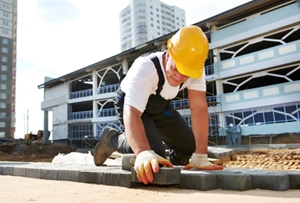Reputable Tuckpointing Services for Mending Block and Rock Surfaces
Reputable Tuckpointing Services for Mending Block and Rock Surfaces
Blog Article
Unlocking the Secrets of Sustainable Masonry Construction Practices for Eco-Friendly Structures
In the realm of contemporary building, the quest of sustainable methods has come to be critical. Among the myriad techniques to environmentally friendly building, lasting stonework building stands out as a time-tested and resilient technique that holds a wealth of untapped possibility. From the choice of products to cutting-edge building methods, the keys to attaining sustainability within stonework building are diverse and fascinating. By checking out the benefits, materials, methods, and future trends of lasting masonry, a much deeper understanding of how these techniques can form the future of eco-friendly structures emerges.
Advantages of Sustainable Stonework Construction
Embracing sustainable masonry construction practices not only lowers environmental effect yet also provides lasting financial benefits to home builders and neighborhoods. By using materials like recycled blocks, blocks, and stones, builders can significantly decrease the carbon impact of their tasks while advertising source effectiveness. Furthermore, sustainable stonework building methods, such as appropriate insulation and thermal mass properties, can improve energy performance within buildings, causing lowered functional prices over time.
Moreover, the durability and resilience of stonework frameworks contribute to lasting financial advantages. Buildings built making use of lasting stonework practices frequently need less maintenance and repair service, converting to set you back financial savings for builders and homeowner. The longevity of stonework products also makes certain that structures continue to be secure and safe and secure, lowering the requirement for frequent restorations or replacements.
Eco-Friendly Masonry Materials
Using green masonry products is a pivotal action in the direction of enhancing the sustainability of construction practices and reducing ecological effect while optimizing long-term financial advantages. Sustainable stonework products are sourced, generated, and used in a manner that minimizes overall ecological impact. Materials such as recycled blocks, redeemed rock, and sustainable cinder block are coming to be increasingly popular selections for eco-conscious building contractors. Recycled blocks, as an example, not only draw away waste from land fills but likewise require much less energy to produce contrasted to new blocks. Redeemed rock uses a special aesthetic appeal while lowering the need for brand-new quarrying. Sustainable concrete obstructs include recycled aggregates and may feature improved insulation homes, contributing to energy effectiveness in buildings.
In addition, all-natural products like adobe, rammed earth, and straw bundles provide exceptional thermal mass residential properties, lowering the requirement for heating and cooling down power. These products are usually locally offered, advertising local economies and reducing transportation-related carbon discharges. By picking environmentally friendly masonry products, construction use this link tasks can substantially reduce their ecological footprint and add to the creation of healthier, extra lasting built atmospheres.
Energy-Efficient Masonry Strategies
Energy efficiency plays a critical role in enhancing the sustainability of stonework construction practices. By executing energy-efficient masonry techniques, contractors can considerably lower the overall power consumption of a structure, causing lower operational prices and a smaller ecological impact. One crucial energy-efficient masonry method is using thermal mass, which includes including dense products like concrete or block into the building's structure to take in and save heat. This aids control indoor temperatures, decreasing the requirement for mechanical home heating and cooling systems.

Developments in Lasting Masonry
Recent developments in lasting masonry techniques have actually produced ingenious techniques that are improving the building sector. One such technology is the development of self-healing concrete, which makes use of microorganisms embedded within the concrete to heal splits autonomously. This advancement not only decreases upkeep prices yet additionally enhances the durability of masonry frameworks, adding to their sustainability.
An additional notable development is using recycled accumulations in masonry construction - masonry contractor. By incorporating materials such as crushed ceramic waste or recycled glass into concrete mixes, contractors can minimize the environmental effect of building and construction tasks while maintaining structural stability. This practice not only diverts waste from garbage dumps however additionally conserves natural deposits, making it a key improvement in lasting masonry construction
Additionally, the assimilation of electronic layout tools, such as Building Info Modeling (BIM), is reinventing the method masonry structures are intended and constructed. BIM enables more precise computations, reduced material wastefulness, and improved power efficiency, eventually resulting in even more sustainable building techniques. These advancements collectively indicate an appealing this future for lasting masonry building in the era of green buildings.
Future Trends in Stonework Sustainability
With the innovative strides made in sustainable masonry techniques, the future trends in stonework sustainability are positioned to additional change the construction market. One of the essential trends forming the future of stonework sustainability is the enhanced combination of modern technology. Improvements such as Structure Information Modeling (BIM) and digital reality simulations are being made use of to optimize stonework building processes, resulting in minimized material waste and improved energy efficiency in structures.
Moreover, the growth of novel sustainable products is readied to play a considerable duty in improving the eco-friendliness of stonework building and construction. masonry contractor. Innovations like self-healing concrete, recycled accumulations, and bio-based binders are acquiring traction for their capability to minimize ecological influence while keeping structural stability

Final Thought
In verdict, sustainable stonework building practices supply various benefits for eco-friendly buildings. masonry contractor. Technologies in sustainable stonework are continually being developed to even more improve the ecological efficiency of structures.
Report this page